Steller Sea Lions at Hornby Island, BC—JANUARY 12-16, 2009
Thursday, January 29th, 2009 at 5:42 pm by Ken
Dive in Canada during January? Well, maybe not as crazy an idea as you might think. Our destination was Hornby Island, which is about 80 miles NW of Vancouver—the “Miami Beach” of Canada. Or so it was described to me by my friend & photo pro Jon Cornforth, http://www.cornforthimages.com, who invited me to accompany him. Jon then got me a great deal re: some shares on a bridge in Brooklyn, but that’s another story. Seriously, Hornby has a great attraction this time of year—the Steller Sea Lions (Eumetopias jubatus) that migrate here each winter from as far north as the Bering Sea to feed on herring, which are gathering to spawn in early March. Stellers are listed as “Threatened” under the Endangered Species Act, and I had never photographed them. Hornby is about 200 miles north of Seattle, so I flew there to overnight, and Jon (a Seattle resident) picked me up for the drive at 10:00am the next day. We arrived safe & sound at Hornby by 7:00pm that evening. The drive—other than ubiquitous rain & fog and a border crossing (gotta remember to bring those passports now, “eh?”)—was uneventful. Much of the nine hours lapsed time was due to coordinating with schedules of the three ferry rides needed to get there—one to Vancouver Island, a second to Denby Island, and a final one to Hornby Island. I called my wife after our arrival that evening, and (since I’d left the house for the airport at noon the previous day) her comment was, “You get to Indonesia faster than that.” We stayed with our very genial hosts Rob & Amanda Zielinski of Hornby Island Diving, http://www.hornbyislanddiving.com. The lodge is two floors of modern, comfortable living space, with private bedrooms and shared large bathrooms on each floor. We had three delicious home-cooked hot meals each day, and there was even a sauna. The lodge can accommodate 16-24, and the usual clientele comes on weekends. We were a special “midweek” private charter that Jon arranged (diving Tuesday thru Thursday), and there were only four of us. Since we were all underwater photographers and thus space pigs by definition, we luxuriated in all the open areas we could clutter up! The Stellers hang out at a place called Norris Rocks. We got there in five-to-ten minutes from the dock (which was less than 100yds from the lodge) in a beamy, 32-foot aluminum dive boat with twin 225HP outboards. While the area can get some nasty winter storms, we had calm water and no rain or snow during our visit. However, we never saw the sun, just overcast skies or fog. This is normal, but too bad, because behind those sea lions and shoreline in the photo above are some really picturesque snow-clad mountains. Steller Sea Lions are lighter in color than the CA Sea Lions (Zalophus californianus) I’m used to, and much larger. A male Steller can grow to 10 feet and 2200lbs (a ton!), while bull California will max out at 8 feet and 900lbs. The F 45 degree water temp (F 37 degree air) dictated diving in drysuits. Until I looked it up after the trip, I hadn’t realized it’s been over ten years since I’d used my drysuit—I’ve really wimped out on tank diving in my native northern California! Fortunately, I experienced no leaks or other problems. I need to wear 39lbs of lead with my drysuit (20 on the weightbelt, 8 each in two pockets on my buoyancy vest, and 1.5 on each ankle), which is 15lbs more than I wear diving with a thick wetsuit. But we never had to venture too far from where we entered the water—the Stellers were more than happy to find us. Sometimes we’d be buzzed by a single, curious individual.
This was the more common greeting, however, especially when we’d first get in. You can see pro photographer Paul Souders (http://www.worldfoto.com) trying to take a picture in the photo above left, but about all you can make out of him in the shot above right is the yellow backup regulator. Oh, and they would BITE, trying to figure out what we were—fins, arms, hoods, hoses and strobe cords were all fair game. Not hard enough to do any damage, but a tad disconcerting when you’re trying to photograph them.
Here are a few group shots I managed to get. We found that if you backed off a few feet after the first mob rush, they would pause briefly before resuming, which allowed us to get in a shot or two. These were all juveniles, but some were in the neighborhood of 600lbs. While we were immediately aware when one of the big bull males swam by because of their size, they didn’t deign to play. Good thing–a bite from something that weighs a ton would no doubt have been a more serious matter! The shot above didn’t work, because my strobes didn’t recycle to fire in time, making the photo too dark and also soft from the slow shutter speed. I included it because of the interesting behavior. That’s a bull CA Sea Lion playing (getting bit) by the juvenile Stellers. Male Californias migrate the “wrong way” up to southern BC in winter from CA & Mexico, also for the herring gathering. Usually I’m trying to get closer to my underwater photo subjects—not the case with the Stellers! This one was trying to eat my dome port, and even though I had a +4 closeup diopter on my 24mm lens, nothing is in focus.
I did better with the “head shots” when they gave me a few inches of breathing room. They seemed to enjoy looking at themselves in the dome port, when they weren’t trying to bite it.
We frequently noticed this “bubble blowing” from the Stellers, but it didn’t seem to denote the aggressive behavior I’ve experienced in the past with bull CA Sea Lions when I ventured too close into what they considered their territory. Well, maybe this one was a tad aggressive, but fortunately it was one of the cute smaller Stellers. I obviously had no time to “compose” this shot—it was a point-and-shoot photo opportunity, and one of my favorites from the trip. While there wasn’t much sunlight, we were fortunate to have calm water on each diving day, and being “mugged” by Steller Sea Lions has to have been one of the most interesting dive/photo encounters I’ve experienced. A great trip! Best to all, |
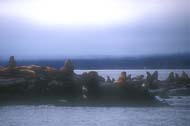
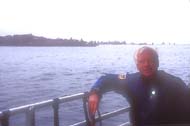
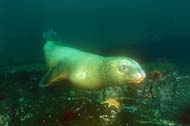
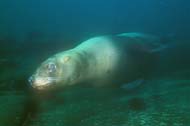
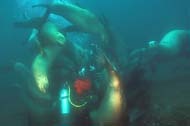
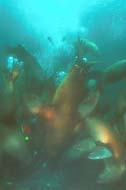
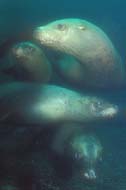
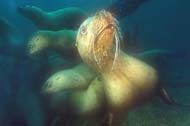
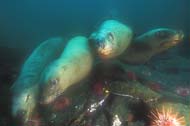
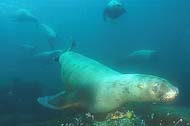
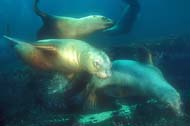
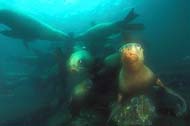
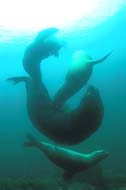
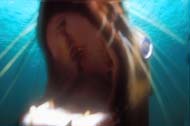
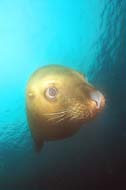
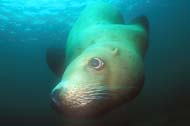
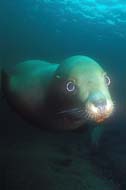
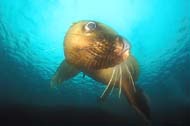
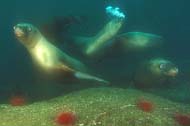
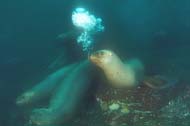
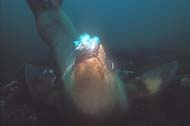
 Permalink
Permalink Filed under:
Filed under: 